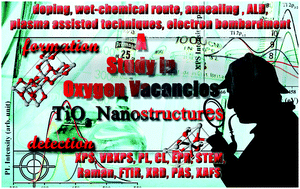The formation and detection techniques of oxygen vacancies in titanium oxide-based nanostructures
Abstract
TiO2 and other titanium oxide-based nanomaterials have drawn immense attention from researchers in different scientific domains due to their fascinating multifunctional properties, relative abundance, environmental friendliness, and bio-compatibility. However, the physical and chemical properties of titanium oxide-based nanomaterials are found to be explicitly dependent on the presence of various crystal defects. Oxygen vacancies are the most common among them and have always been the subject of both theoretical and experimental research as they play a crucial role in tuning the inherent properties of titanium oxides. This review highlights different strategies for effectively introducing oxygen vacancies in titanium oxide-based nanomaterials, as well as a discussion on the positions of oxygen vacancies inside the TiO2 band gap based on theoretical calculations. Additionally, a detailed review of different experimental techniques that are extensively used for identifying oxygen vacancies in TiO2 nanostructures is also presented.

- This article is part of the themed collection: Recent Review Articles


 Please wait while we load your content...
Please wait while we load your content...